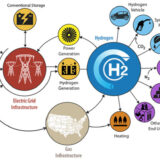U.S. DOE releases two studies from Co-Optimization of Engines & Fuels initiative
The U.S. Department of Energy (DOE) has released two studies from the Co-Optimization of Engines & Fuels initiative (Co-Optima).
The Co-Optima initiative aims to co-develop advanced engine technologies and fuel components to significantly increase fuel economy over today’s vehicles. While advanced engine designs are being introduced commercially, they are limited by current fuels. Co-Optima explores fuel and engine innovations that work together to maximize vehicle performance and fuel economy. The advanced fuel components can be derived from domestic biomass resources, which can increase U.S. energy security and create jobs in rural America.
The study, Fuel Blendstocks with the Potential to Optimize Future Gasoline Engine Performance, identifies eight representative high-octane blendstocks across five chemical groups that could be blended into gasoline for better performance. These new blendstocks, co-optimized with advanced gasoline engines, show potential to improve passenger vehicle fuel economy by 10%.
The companion study, Efficiency Merit Function for Spark Ignition Engines, outlines a new mathematical equation which quantifies the fuel efficiency potential associated with different fuel properties. The goal of this research is to provide American industry with the scientific foundation needed to maximize vehicle and fuel performance and efficiency, thereby enabling increased fuel economy and more affordable transportation. For a typical American household, transportation costs are second only to housing expenses.
“Increasing the efficiency of internal combustion engines is one of the most cost-effective approaches to improving the energy efficiency of new vehicles in the near- to mid-term in conventional, hybrid and plug-in hybrid electric vehicles,” said Principal Deputy Assistant Secretary for the Office of Energy Efficiency and Renewable Energy Daniel Simmons. “Researching engines and fuels as a system offers the opportunity to improve the affordability and efficiency of future gasoline engines for American families and businesses.”
The representative blendstocks identified in Fuel Blendstocks with the Potential to Optimize Future Gasoline Engine Performance can be blended into gasoline and used in smaller but more powerful and efficient spark-ignition engines. The study explored and evaluated a broad and diverse range of blendstocks across chemical groups that could be derived from domestic sources, including natural gas, petroleum and biomass. The assessment criteria included physical properties, high-level health-impacts, the ability to improve advanced spark-ignition engine efficiency and the potential to be introduced commercially in the 2025–2030 time frame.
The research into fuel property impacts on engine efficiency and performance detailed in the first study was guided and informed by a new engine efficiency merit function, or mathematical equation. Efficiency Merit Function for Spark Ignition Engines documents the development of this merit function and how it can be used to improve the scientific understanding of the dynamic relationship between fuel properties, including octane and engine efficiency.
Under Co-Optima, DOE’s Office of Energy Efficiency & Renewable Energy brings together nine national laboratories, 13 universities and numerous industry and government stakeholders. Working together, these partners explore technologies with the potential to achieve near-term enhancements to the types of fuels and engines found in most vehicles currently on the road as well as revolutionary engine/fuel technologies that may enable longer-term, higher-impact future solutions.
The next phases of Co-Optima will validate these potential fuel efficiency improvements through engine testing and also begin examining fuel efficiency gains in heavy-duty diesel engines.








.jpg)
